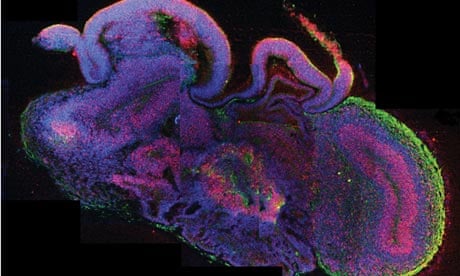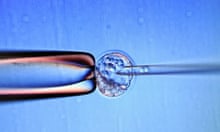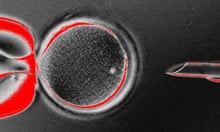Scientists have grown miniature human brains in test tubes, creating a "tool" that will allow them to watch how the organs develop in the womb and, they hope, increase their understanding of neurological and mental problems.
Just a few millimetres across, the "cerebral organoids" are built up of layers of brain cells with defined regions that resemble those seen in immature, embryonic brains.
The scientists say the organoids will be useful for biologists who want to analyse how conditions such as schizophrenia or autism occur in the brain. Though these are usually diagnosed in older people some of the underlying defects occur during the brain's early development.
The organoids are also expected to be useful in the development and testing of drugs. At present this is done using laboratory animals or isolated human cells; the new organoids could allow pharmacologists to test drugs in more human-like settings.
Scientists have previously made models of other human organs in the lab, including eyes, pituitary glands and livers.
In the latest work researchers at the Institute of Molecular Biotechnology in Vienna started with stem cells and grew them into brain cells in a nourishing gel-like matrix that recreated conditions similar to those inside the human womb. After several months the cells had formed spheres measuring about 3-4mm in diameter.
"The cerebral organoids display discrete regions that resemble different areas of the early developing human brain. These include the dorsal cortex identity – the dorsal cortex is the largest part of the human brain. They also include regions representing the ventral forebrain and even the immature retina," said Madeline Lancaster, who was first author of the paper published in Nature on Wednesday.
Jürgen Knoblich, who was part of the team that created the organoids, said that tests on the brain cells in the structures showed that they were functional.
"Previous models were pieces of small tissue that aggregated to a decent size but there was no success, so far, in generating something that would resemble the cortex in a particular stage of development."
To show how effective the organoids could be in illuminating brain disorders, Knoblich and Lancaster teamed up with neurologists from Edinburgh University to grow brain tissue that modelled the developmental disease microcephaly, a condition where the brain grows to a much smaller size than normal, leading to mental disability.
"When I looked at the organoids derived from the microcephaly patient cells, the immediate thing I noticed was that [their] overall size was much smaller than the organoids derived from control, healthy cells," said Lancaster.
The reason, she said, was that brain stem cells normally undergo many rounds of cell division before finally turning into brain cells. But in microcephaly patients, the stem cells begin turning into brain cells too early, leading to a depletion in the overall number of brain cells.
Zameel Cader, a consultant neurologist at the John Radcliffe Hospital in Oxford, said: "This is a fascinating and exciting piece of research extending the possibilities of stem-cell technologies for understanding brain development, disease mechanistics and therapy discovery, as well as hopes for regenerative medicine."
He said the organoid was "audacious and the similarities with some of the features of a human brain really quite astounding".
Cader said one similar feature was "the fact that a considerable degree of the brain complexity and patterning is [being] encoded and which could arise from the DNA of the starting stem cells without additional external manipulations".
Paul Matthews, a professor of clinical neuroscience at Imperial College London, said that what made the observations so exciting was that cells from the patient with microcephaly developed into an abnormal organoid with features analogous to many of those existing in the patient. "The investigators then showed that these abnormal features could be 'cured' by replacing the defective gene."
Knoblich said that the team's goals included growing larger organoids and modelling more brain diseases.
At the moment the structures did not grow larger than a few millimetres in the culture dishes because nutrients and oxygen could not reach into the centre of the organoids as they grew. To grow much bigger they would need to be equipped with a blood supply of some kind that could feed their centres.
He added that they were unlikely to reach the complexity required to model cognition or any other higher brain function, and the intention of the research was not to grow replacement brain parts or an entire brain in culture.
"I have to be pessimistic about this. The ultimate complexity of the brain will not allow any replacement of structures," he said. "In the adult brain all the parts are intimately integrated with other areas of the brain. It would be very hard to repair defects with this."






Comments (…)
Sign in or create your Guardian account to join the discussion